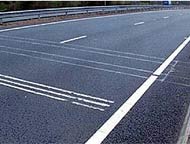Article from: www.thenewspaper.com/news/10/1009.asp
3/13/2006
Speed Camera Manual Discloses Accuracy Problems
Potholes, cracked pavement, worn-out shock absorbers and other common problems may cause inaccurate speed camera readings.
 According to a New South Wales, Australia Roads and Traffic Authority manual, there are several known sources of inaccuracy in speed camera technology using embedded pavement sensors. Last month, Scottsdale, Arizona began using this method on the Loop 101 freeway, putting an Australian vendor in charge of the ticketing program.
According to a New South Wales, Australia Roads and Traffic Authority manual, there are several known sources of inaccuracy in speed camera technology using embedded pavement sensors. Last month, Scottsdale, Arizona began using this method on the Loop 101 freeway, putting an Australian vendor in charge of the ticketing program.
Technical Manual EN 62, obtained by The Sydney Daily Telegraph newspaper, admits between three and ten percent of automobiles "may give zero speed results" and "this is absolutely normal." The error is caused by vehicles with worn-out shock absorbers and unbalanced wheels that confuse the pavement sensors. Bankrupt manufacturer Poltech recommends when the error rate exceeds ten percent the camera should be sent in for service.
Although Poltech went bankrupt after 160,000 inaccurate tickets were refunded in the state of Victoria, its pavement sensors were manufactured by Truvelo and MSI and are still used by other Australian camera vendors. Common problems such as potholes or pavement cracks within 160 feet of the sensor also affects their accuracy.
Cameras manufactured by Redflex, Traffipax and Redflex can only capture five vehicles per second meaning drivers in close groups on freeways may not be identifiable. Traffipax cameras shut down after temperatures inside the camera housing exceed 104 degrees Fahrenheit for prolonged periods.
According to the manual, the device has a 1.25 MPH margin of error under 62 MPH, and a 2 percent error rate above that speed. The manual states that this inaccuracy, "complies with international standards." Most cameras also cannot process speeds below 12 MPH or above 158 MPH. For Traffipax, these speeds are "outside the manufacturer's specified detection range."
Source: Speed secrets (Daily Telegraph (Sydney, Australia), 3/13/2006)
Permanent Link for this item
Return to Front Page
 According to a New South Wales, Australia Roads and Traffic Authority manual, there are several known sources of inaccuracy in speed camera technology using embedded pavement sensors. Last month, Scottsdale, Arizona began using this method on the Loop 101 freeway, putting an Australian vendor in charge of the ticketing program.
According to a New South Wales, Australia Roads and Traffic Authority manual, there are several known sources of inaccuracy in speed camera technology using embedded pavement sensors. Last month, Scottsdale, Arizona began using this method on the Loop 101 freeway, putting an Australian vendor in charge of the ticketing program.